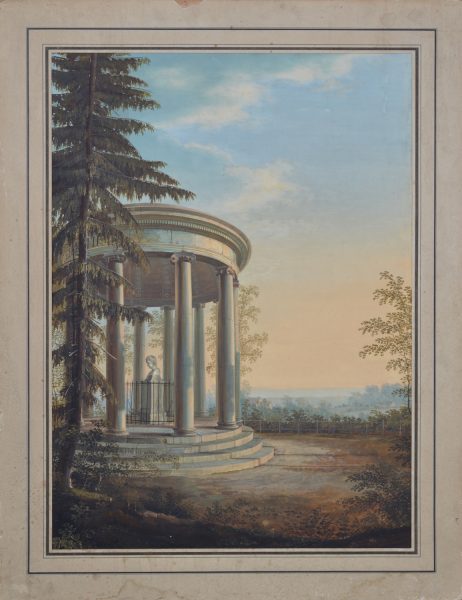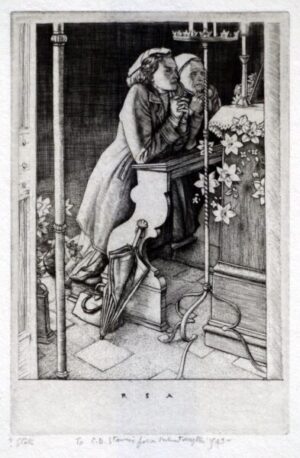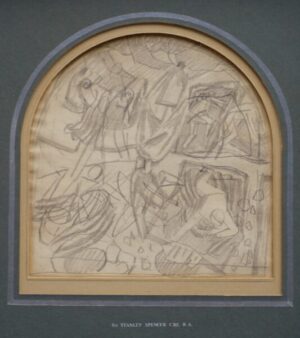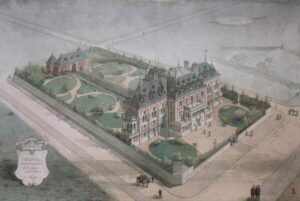Description
The Leibniz Temple (also called the Leibniz Monument) is considered to be the first public monument in Germany for a non- noble. The open, roofed round temple made of sandstone with twelve Ionic columns bears the inscription “Genio Leibnitii” in gilded letters. The letters are partially visible through the tree on the left side of the painting.
In the middle of the temple, on a pedestal is the bust of Leibniz, made of Carrara marble which the Irish sculptor Christopher Hewetson had created in Italy. The bust was first erected in 1789 in the house of the Hanoverian statesman August Wilhelm Rehberg before it was placed in the temple in 1790. In 1986 the bust was relocated to the Hanover Technology Centre and eventually found its way to the Herrenhausen Palace Museum in 2013. On July 1, 2010, Leibniz’s birthday, a cast concrete copy of the Leibniz bust was erected in the Leibniz Temple.
Gottfried Wilhelm Leibniz (1646-1716) was a German polymath active as a mathematician, philosopher, scientist and diplomat who invented calculus in addition to many other branches of mathematics, such as binary arithmetic, and statistics. Leibniz has been called the “last universal genius” due to his knowledge and skills in different fields and because such people became much less common after his lifetime with the coming of the Industrial Revolution and the spread of specialized labour. He is a prominent figure in both the history of philosophy and the history of mathematics. He wrote works on philosophy, theology, ethics, politics, law, history, philology, games, music, and other studies. Leibniz also made major contributions to physics and technology, and anticipated notions that surfaced much later in probability theory, biology, medicine, geology, psychology, linguistics and computer science.
Brand
Ramberg, Johann Heinrich (German, 1763-1840)
Johann Ramberg's talent for drawing was recognized and encouraged by his father at an early age. His album with views of the Harz Mountains, which he had visited in 1780 with Pascha J.F Weitsch (1723–1802), was presented to King George III in London. He was then awarded a scholarship to the Royal Academy from 1781 to 1788, where Benjamin West taught him history painting. He quickly achieved success with satirical drawings, models for engravers, portraits and an altarpiece for the German Chapel in St. James'. John Boydell commissioned him to paint the Malvolio scene from Twelfth Night (Yale Centre for British Art, New Haven, Connecticut, USA) for his Shakespeare Gallery.
Back in Hanover, Ramberg gained recognition with a curtain painted for the opera house (Apollo in his chariot, 1789, burned in 1943). He trained in etching in Dresden and travelled via Vienna to Venice, Rome and Naples in 1791/92. After his return he contacted the publisher Göschen in Leipzig. This marked the beginning of Ramberg's constant and rich production of book illustrations, including for the famous Wieland edition 1794-1802, for texts by Schiller, Goethe and Gellert, as well as for almanacs and pocket books.
In 1793, Ramberg was given the permanent position of court painter and theatre decorator in Hanover. All Ramberg's wall and ceiling paintings, for example for the stock exchange or Herrenhausen Palace - mostly with allegorical depictions - have been destroyed and, like numerous festive decorations, are only documented in drafts (today mainly in the Lower Saxony State Gallery in Hanover). Works from all genres of painting (historical, military, landscape, genre and portrait paintings) in oil and gouache are known. His graphic works with folk scenes, memories of Italy and erotic depictions sold well.
Ramberg's greatest talent remained drawn caricature and satire. He illustrated classical texts and folk books in folio format and designed a picture story himself. Probably because of the war, only a few were printed: Wieland's "Oberon" 1803-04 (40 gouaches, Biberach, Wieland- Mus.), Homer's "Odyssey" 1805, the "Iliad" 1805-07, "The Eunuch" by Terence, "Accidents in Carriages and on Horseback", 25 scenes from the "Life of Strunk the Upstart", a rustic fool with his companion Israel 1822-25, 28 "Councillors". In 1826 Ramberg published two albums with etchings "Reineke Fuchs" and "Tyll Eulenspiegel" and in 1828 "Homer's Iliad, serious and comic" (10 pairs of sheets).
Ramberg died at Hanover and was buried in the Gartenkirchhof.



